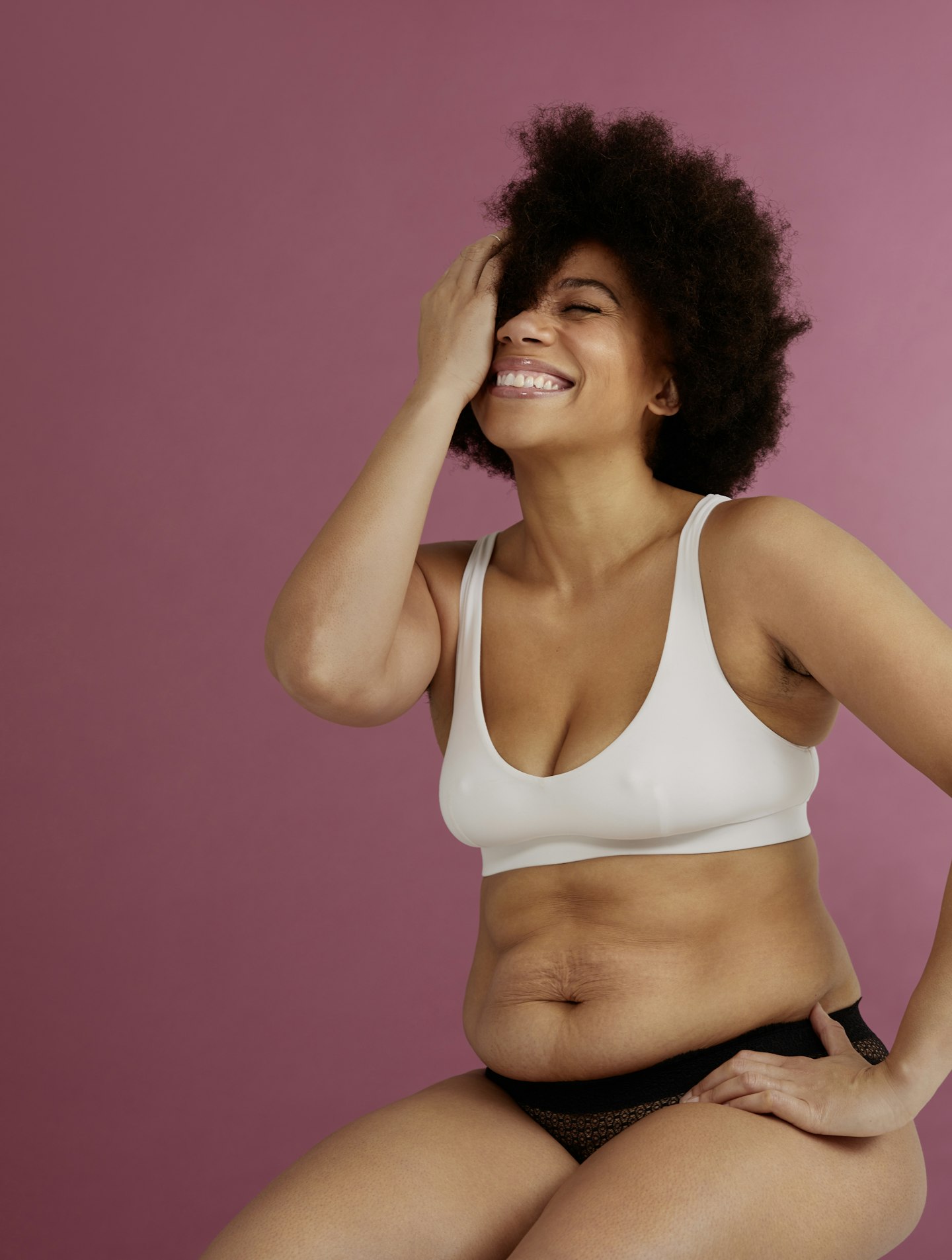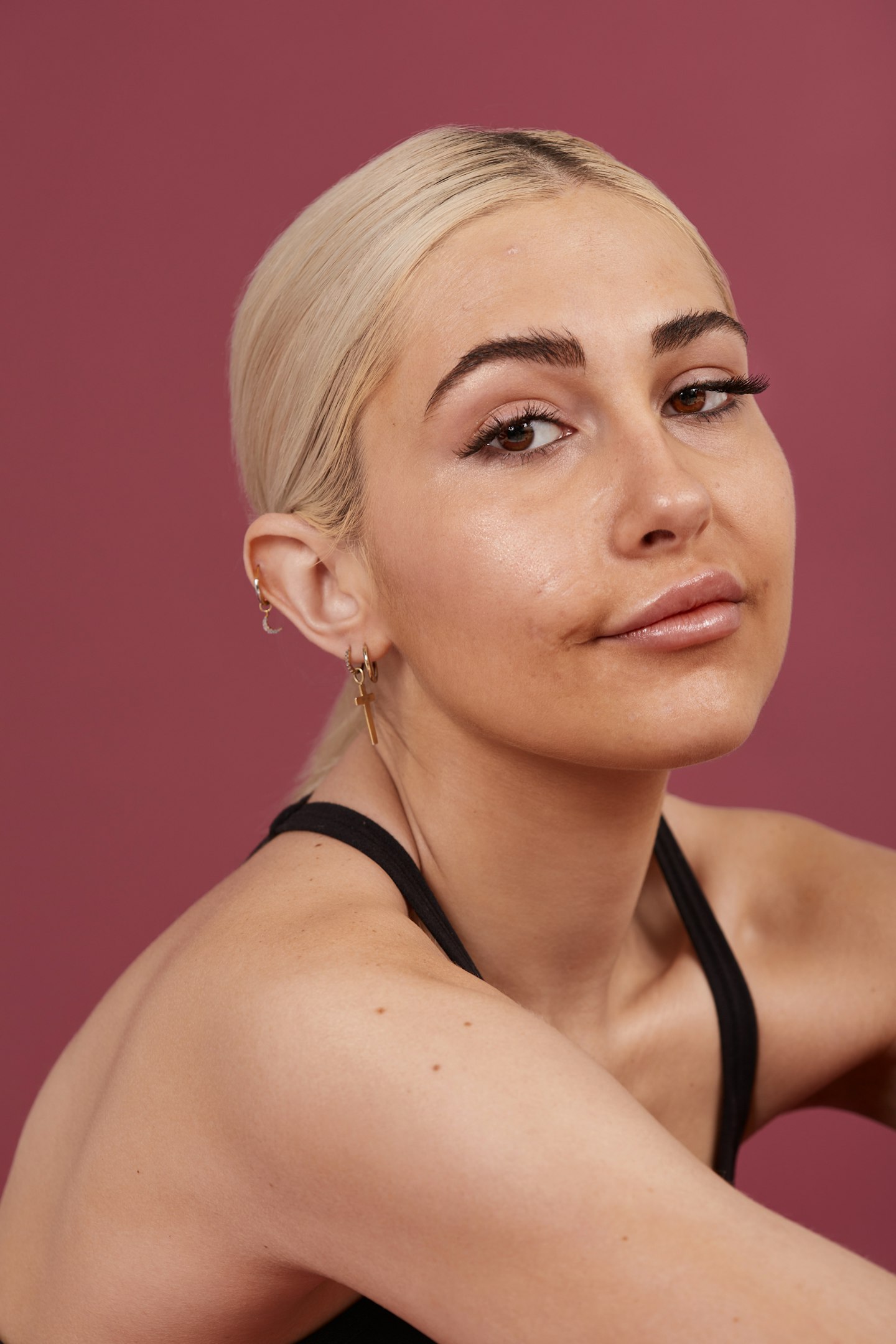Photographs: Natasja Fourie
Words: Laura Antonia Jordan
Direction: Joely Walker
Hair & Make-up: Neusa Neves at Terri Manduca using Nars Cosmetics and Aveda Haircare
Production: Anna Dewhurst
Production Assistant: Emma Stoddart
Our scars are souvenirs of our experiences. They are visual remnants of adversity overcome and pain suffered, of a lifetime of stoical endurance and moments of reckless abandon, of babies born and tumours removed. They are triumphs of our strength and resilience, of our bodies changing and growing. Our scars hint at the heroes inside us. Leonard Cohen wrote that children wear them ‘like medals’ – so why can’t the rest of us?
Of course, there are the obvious associations with pain. ‘If an individual has experienced a trauma that has resulted in scarring, then this emotional connection with the event may be revisited by the person every time they look at their scar,’ explains leading scar therapist Hannah Poulton of Reactiv8 Therapy.
But there is also the issue of exposure: we are not used to seeing them. Although slowly we are beginning to witness greater diversity in terms of size, race and age in the media, so often we still see these bodies through an airbrushed lens where the skin is ‘perfect’ (read: unrealistic). Eye bags are brightened and laughter lines flattened, veins concealed and bruises masked. When was the last time you saw a model with a flush of eczema on her legs, or a leading lady with a sprinkling of spots on her cheeks? Exactly. It can often feel like the implicit message is ‘diversity is great... If it can be wrapped up in a nice airbrushed package.’
Still, there is progress. Thanks to the success of brands like Fenty Beauty, Milk Makeup and Gucci Beauty (whose debut campaign featured wonky teeth), the beauty industry has begun to take tentative steps away from the perfection myth. In terms of skin, Gillette Venus put Marika Nagy, who has congenital naevi – a condition that means she is covered in birthmarks head to toe – in one of its campaigns last year; US skincare brand Blume used models who have acne to promote acne products (obvious yet radical!). Meanwhile, Winnie Harlow, the supermodel and vitiligo campaigner, is unstoppable. She has scooped campaigns for, among others, CoverGirl and KKW Beauty.
But beyond brands, it’s women like those here who are changing the narrative, helping to eradicate shame by exposing their scars and blemishes. They are unafraid to show a stretch- marked tummy or answer questions from curious strangers about how they got a scar on their face.
‘Seeing more images of people with scars and learning about their journey to acceptance will engage and educate individuals all over the world,’ says Poulton. ‘Scars are as unique to the person as their own fingerprint. It is so important that we acknowledge the beauty in differences, that they are part of the person, and help support everyone on their journey to recovery. For us, scars are beautiful.’
‘The texture of “normal” skin is beautiful and different,’ agrees Natalie Lee, 39, an influencer (read on for her story). ‘Skin is our body’s biggest organ and it’s so fascinating, so amazing how it evolves, how it can repair itself. We need to love the skin we’re in so much more than we do.’
Stephanie Yeboah, 30

When writer and influencer Stephanie Yeboah went on holiday, she used to wear a cardigan at all times. The reason? The stretch marks on her arms that she ‘hated’ (that was one of the less painful methods of concealment; she also tried tattooing and having carbon dioxide injected into her skin). ‘I used every single thing that people recommended online and they wouldn’t go.’
What did work was changing her mindset. ‘It just got to a point where I was like, “Why am I working so hard to get rid of these marks?” They just show that I was smaller and I went through puberty and got bigger. They don’t mean that I’m a horrible person. Stretch marks don’t mean that you’re dirty or that you’re lazy or that you’re unclean or slow, it just means that your skin has stretched. Because of society’s stigma with associating stretch marks with fatness and obesity, they’re vilified. They represent everything that society thinks is “wrong” with our bodies. By choosing to fall in love with my body, including my stretch marks, that’s me taking back the power.’
Stephanie wants her 52k Instagram followers to take back their power, too. Her Instagram (@stephanieyeboah) is a celebration of the joy of fashion and dressing up. She rocks power suits, exuberant printed dresses and bikinis. ‘I want people to know that you can be fat and you can wear mesh and crop tops and short shorts,’ she says. ‘I get a lot of feedback, specifically from younger, black, plus-sized girls who feel like they have never seen or not had any representation to cement the fact that they are worthy and beautiful.’
Natalie Lee, 39

Before Natalie Lee, 39, had children, she didn’t think about her body much. Although she loved being pregnant – ‘the most feminine I’ve ever felt’ – she wasn’t prepared for how it would change her physically. ‘I was left with what I thought were really severe stretch marks and a very wobbly stomach. No amount of dieting or exercise would help, and I was very down about it. I just remember thinking that I can’t carry on like this. I didn’t want to be that kind of person, especially for my girls. So I decided to go on this journey and change how I thought, get my confidence up and inspire my children.’
Natalie’s journey has involved using her Instagram (@StyleMeSunday, 77k followers) to show off her body and broaden the conversation about self-confidence. ‘I used to be so ashamed of my stretch marks and my Caesarean scar and my wobbly stomach, but now just exposing and letting it all hang out, so to speak, really helps to eradicate that shame.’ She uses the hashtag #PrettyFuckingAverage as a pertinent reminder that the things we are conditioned to think are ‘wrong’ about our bodies are actually normal.
Today she appreciates that ‘my body tells my story and my children came from my stomach with all the stretch marks. I used to hate them, whereas now I absolutely adore them. My children love to squish my stomach,’ she laughs. ‘I wish I could’ve just told myself earlier that there are much more important things to be thinking about and that it’s really nice to just feel what your body can do, rather than looking at it and dissecting it all of the time. There’s nothing wrong with getting older and just being in your own skin that’s ever evolving and changing. I don’t feel like it’s being big-headed to say that I feel beautiful because I really do. And I don’t need anyone else to tell me.’
Grace Latter, 26

‘My friend affectionately calls it my “front butt”,’ laughs Grace Latter, pointing to the vertical scar on her stomach. ‘I call it my second cleavage. Much nicer!’ Irrepressibly optimistic, Grace got her scar from two bowel surgeries. She also has a prominent scar on the side of her head, the result of three brain surgeries.
Despite the pain of the procedures, Grace says she ‘loves’ her scars, and although she admits ‘it’s not all been positive and amazing’, she says her experiences have given her a privileged perspective on life. ‘I was so much more self-conscious about my body before I got these scars, which is crazy when I think about it. I was your average teenage girl, but I remember feeling so isolated and thinking that how I looked was wrong in so many ways. I didn’t see myself in anyone in the media, and I would aspire to having a flat tummy and a flat butt.’
Now Grace refuses to shy away. She modelled in Dove’s Show Us campaign, has 14 tattoos and, in 2018, shaved her head for charity – something she would ‘highly recommend’ for confidence – unapologetically revealing her head scar in the process. ‘I was doing pretty well before, but it’s changed so much for me because, as soon as you make a big commitment to your appearance like that, you have to own it.’
Grace’s self-confidence is equally impressive and inspiring. What’s her secret? ‘One of the reasons why I love my body is because of how much it has done for me and how much it has had to endure and come back from,’ she says. ‘You only have this life, you only have this body and you can do different things with it: decorate it with tattoos, dress to express yourself and grow to love what you have and what you’ve been given.’
Suzel Mackintosh, 25

‘The world is filled with pretty girls, we need to add a different category: badass girl with a story. That’s really interesting,’ says Suzel Mackintosh, an influencer who, with her penchant for grills and baggy clothes, arguably fits both categories. It’s been a little over two years since Suzel’s life changed dramatically. While camping with friends in her native Australia on New Year’s Eve 2017, she went to pat a friend’s dog; it attacked her. ‘It ripped my face apart,’ she says. ‘My nose was hanging off to the side, my smile went up to my cheekbone.’
Suzel was, understandably, ‘crushed’ by the experience. Having moved to London with dreams of becoming a model, she felt that her face – her professional currency – ‘had been taken away from me’.
It took Suzel time to accept her facial scars – she suffered anxiety and depression as a result. But today she has come to recognise that they have given as much as they have taken away. ‘I had a bit of a reality check and realised not everything is about looks. It’s what comes from within. It changed me a lot – for the better. I was always a nice person, but I was naive as well,’ says Suzel, who adds she felt like ‘a shiny toy’ previously. ‘It felt like I was reborn. The person I was before I had these scars is like a distant memory now. I really feel like I’ve had an ego death.’
An active Instagrammer (@suzelmackintosh; 35.4k followers), today Suzel is unafraid to do things on her own terms. She hopes her followers can be galvanised by seeing her owning who she is. ‘It is what it is. It’s my story. If I can move on from this, hopefully other people can find strength through me.’
READ MORE: Scarlett Moffatt: ‘I’ve Had To Ring The Samaritans Because Of Years Of Trolling’
